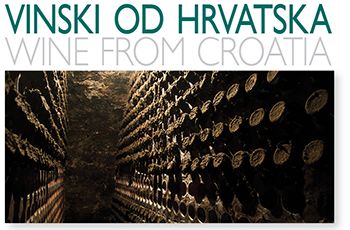VINSKI OD HRVATSKA Wine from Croatia
KNEŽEVI VINOGRADI, Croatia I try never to waste an opportunity to experience unfamiliar wine, especially in a municipality called “prince’s vineyard”. I found there’s more to drinking in southeastern Europe than Slivovitz, plum’s leap to immortality.
Croatia (Republika Hrvatska to the 4.5 million inhabitants), an area about twice that of Massachusetts, in the northwest corner of the Balkans, is a crescent draped over Bosnia. Unlike states farther east, it is predominantly Roman Catholic and uses the Roman alphabet – though Croatian seems impoverished of vowels. Its eastern neighbors, of the Eastern Orthodox persuasion, write with Cyrillic characters. Croatia is urbanized, literate, industrialized. It is a place where “Tito” does not evoke a baseball manager.
Like its neighbors, Croatia has a lot to live down. It was inhabited in prehistoric times, later colonized successively by Illyrians, Greeks, who introduced viticulture, and Romans, who advanced the wine culture. Slavs migrating from the east, settled here in the early seventh century. The area was threatened or occupied in ensuing centuries by Franks, Celts, Ostrogoths, Huns, Mongols, and Venetians, then dominated by Hungary and the Ottoman and Hapsburg empires. After the First World War, Croatia became part of the cobbled-together Yugoslavia (“land of the southern Slavs”). Fascist Croatia’s unspeakable atrocities during World War II were followed by inclusion in Tito’s nationalistic, communistic Yugoslavia. (Tito, born Josip Broz, was a Croat.) After declaring independence in 1991, Croatia was embroiled in an internecine, uncivil war with the Serbs – the physical scars remain plainly evident. No faction earned merit badges. The Baranja viticultural subregion had been held in house arrest during the war. Fighting ceased in 1995. An un-Balkanlike period of peace and relative prosperity (initially abetted by considerable aid) continues. Croatia joined the EU on July 1, 2O13.
Croatia is really composed of two distinct wine-producing nations: the Istrian and Dalmatian coasts and islands on the Adriatic Sea and the inland region (Kontinentalna Hrvaska) beyond the hills. Many of us are aware of plavac mali, the tribidag/crljenak kaštelanski/primitivo/zinfandel scion grown near the coast, but the other Croatia, where I nosed around, is terra incognita. Inland Croatian wine production encompasses several subregions. One of the most notable is the Baranja (“mother wine” in Hungarian), in the northeast corner of the country between the Drava and Danube rivers, north of Osijek, bordering Hungary to the north, Serbia to the east, and the Slavonian oak forest to the west. The area has sizable minorities of Serbs and Hungarians. The prime vineyards lie at about 22O meters on south-facing slopes called by the Romans Mons Aureus (“golden hill”), in Croatian Bansko Brdo or Banska Kosa, usually “Goldberg” on wine labels. While red wines are prominent on the coast – Bordelais varieties, refosco, gamay, pinot crno (noir), and natives – inland vineyards mostly grow whites: graševina, gewürztraminer, pinot blanc, riesling, sauvignon blanc, chardonnay, sémillon, and indigenous varieties. The local vignerons believe that one of chardonnay’s parents, gouais blanc, is a homeboy.
Graševina is the predominant variety here, widely grown in southeastern Europe, including in the northeast of Italy and in China. It is better known as, depending on where you are, welschriesling, wälschriesling, olaz riesling, laski riesling, rizling vlassky, or riesling italico. Unrelated to true riesling, and suffering in comparison, especially in Germany, graševina deserves more respect.
Podruni Belje is the oldest and largest wine producer in the region. It farms several hundred hectares of vines, and issues forth about three million liters of wine annually from its 5OO-year-old cellar, modernized internally in 2OO9. It is a division of the agricultural giant Agrokor. Let’s taste a trio of its vinskis.
Graševina 2O11 Good fruit and finish, texture (like Pinot Gris or Sémillon) and character. Dry. Polished. Very good job. Chardonnay 2O11 Suave integration of fruit with sweet oak. Finishes well. Merlot 2OO9 Light and balanced. Decent finish. Youthful. Hardly remarkable.
We may be seeing more vinski from Hrvatska in our market soon.

